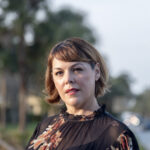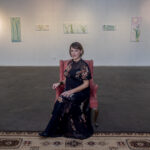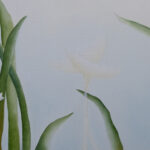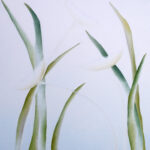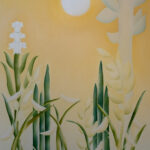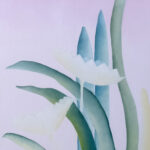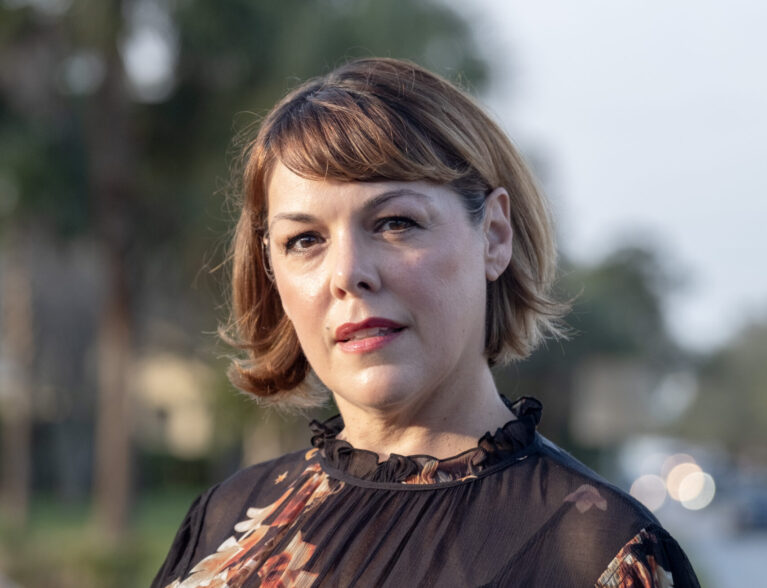
“The designer in me is always trying to understand the perspective of the viewer and what they bring to the experience of art,” says artist Gabriela Hernandez.
Born in Mexico, to an American mother and Mexican father, she lived as a child in Connecticut, before moving to Vero beach in 1983, where her mother was hired as a French teacher at Saint Edward’s School.
Hernandez recalls that her first foray into the art world began on a trip to France with students in her mother’s class, where they visited the Louvre.
“Once we walked in, I remember looking at the Delacroix, in particular, the scale. It just pulls you in and takes you to a different place. That left an impression on me at an early age,” she recalls.Hernandez began taking art classes at St. Edward’s, where small class sizes meant the teacher could spend time with each student, while providing a quiet, calm and supportive space for them to enhance their skills.
She says the school fostered spiritual education as well as an academic education, which she says has continued to be a foundation for her throughout her life. The ties she made at the school also made it easy to return to Vero.
“All my roots were already here,” she says.
After graduating in 1987, Hernandez attended and received a BFA from Pratt Institute in New York, where she began experimenting in installations.
“Paintings were limited in terms of a viewer experience. I felt installation work actually allowed the viewer to puncture the viewer plane and go in and derive their own experiences, as opposed to paintings that dictated what you can see,” she says.
She recalls viewing a video installation at the Whitney Museum, where different images were projected onto each of four walls.
“It was more cutting edge, more experiential, which is interesting because now as we go into virtual reality, and these sets that people put on their heads, it’s exactly the same thing.”
Graduating from Pratt, Hernandez moved to Boston, where she lived for 10 years, taking jobs as a designer at the news magazine the Atlantic, and later at Artists for Humanity, an arts program for at-risk children from poorer areas.
“When the kids showed up, I was just floored by the camaraderie between, not only the students, who came from all different schools, but with the mentors and these young boys and girls,” says Hernandez.
“It was a safe place to explore your identity, be creative,” she adds, likening it what she had experienced at St. Edward’s.
She also took on part-time jobs, at an after-school program at Charlestown High School, primarily for immigrant children, and Saturdays at a charter school in Dorchester.
“I really enjoyed working with kids, helping them explore themselves in this world,” says Hernandez, noting that it gave students an opportunity to assimilate by expressing themselves through the arts.
In 2003, attracted to a master’s program at Harvard focused on arts and education, she received a Stephen J. Ross Fellow, for the community work she performed the year before.
“It was extremely helpful; it paid for half of my tuition,” says Hernandez. She obtained a Master of Education in arts and learning and, among other positions, served as director of education at Louisiana State Museum.
Eventually making her way back to Vero, she says she didn’t see a lot of abstract art and wondered if people would understand her work, what she calls “color field abstract.”
So, she switched to a more decorative style, which became the genesis of her current series, featuring lily leaves and flowers.
“I want to put you someplace that’s more meditative, more passive and reflective,” she explains, adding that she explores the color fields of the leaves and flowers. The colors she uses are meditative, such as a series of four paintings of the same leaf, where the color changes reflect the four seasons.
“It comes from my head, striving to create something that has an almost tactile experience.
The goal isn’t to recreate nature, it’s to create a mood, a space of quiet,” she explains.
Since moving back, she says she is enjoying the artistic diversity of the area.
“I think it’s important to bring a contemporary perspective to art in Vero Beach. The museum does some very interesting things.”
Her work has been exhibited in a show that runs through December at the Raw Space Gallery, a multidisciplinary, arts-driven community space. Also in the current show are photographer David Bence, along with two of her former students, Christina Bates and Peter Polk.
Hernandez says the space, which combines music and the visual arts, creates an atmosphere where people can reflect and experience the arts, rather than just buying and selling it. She is already planning to offer some installations there next year.
“I proposed a space called co-lab and it would be two-month runs, the first being just me. And then every installation after that will be me working with another local artist creating an installation in the space.
“We have a tendency to get locked into what we think our art should be like, and then we become almost duplicates of somebody else,” says Hernandez.
But, she adds, when you combine the different elements of various well-known artists with what excites you, who you are as an artist will shine through.
When teaching, she begins with basic art elements and the principals of variety, harmony and balance.
“I think that’s what delineates a hobbyist as opposed to an artist,” she says, explaining that it is then that artists begin to have serious conversations with themselves about what they are trying to convey.
Hernandez says she is starting to get back to painting abstract works, while also exploring light and color.
“The older style is more active, more tactile, aggressive. They force you to feel something. There’s a level of agitation. More provoking a sensation.”
While admitting that her professional trajectory has been “all over the place,” she says it stems from a Pratt professor who once advised that ‘life has a barrelful of experiences.’
“That has driven me. Everything I’ve done, whether it’s teaching or helping kids express themselves,” says Hernandez.
Photos by Joshua Kodis

